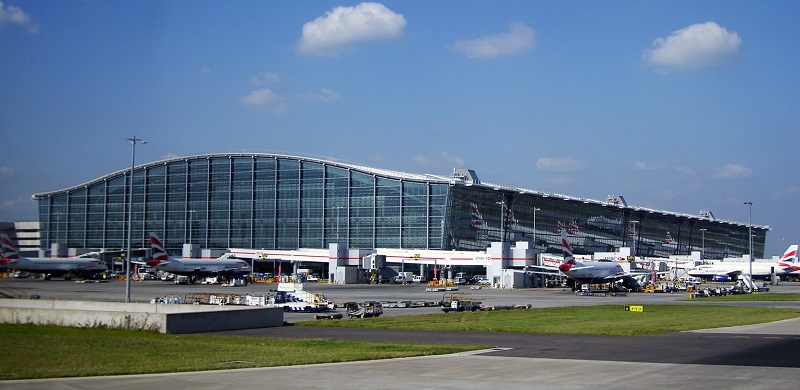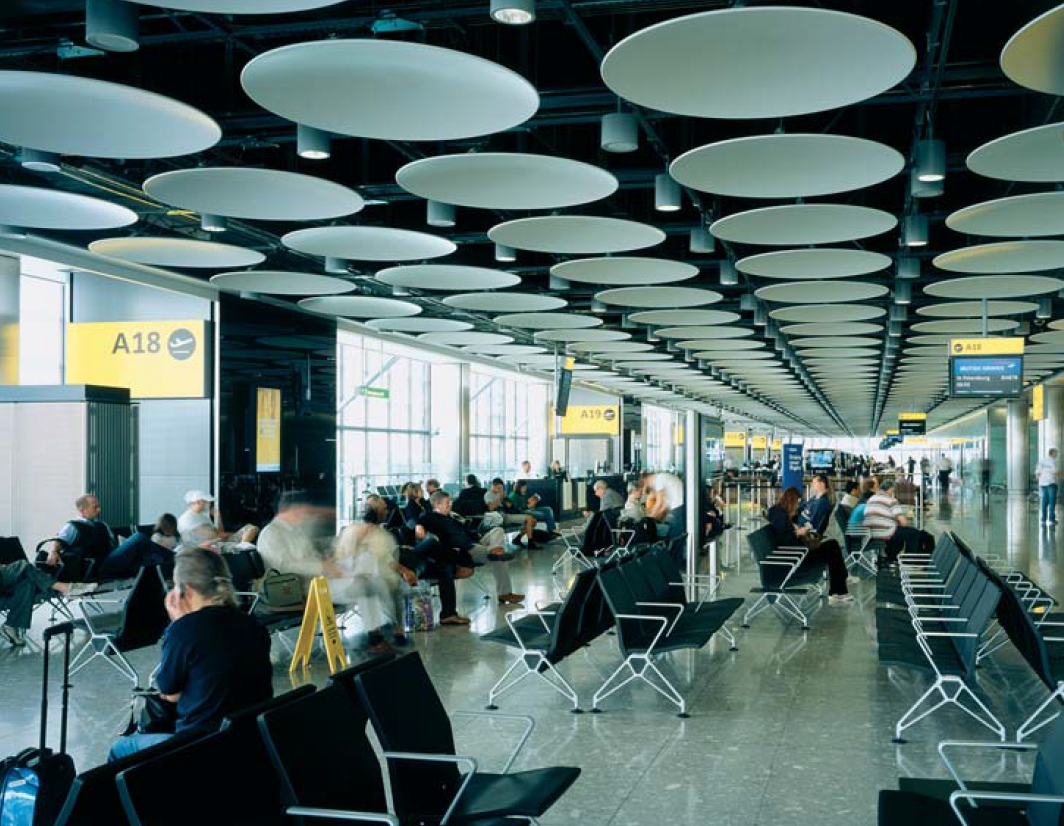Heathrow Terminal 5
Heathrow Terminal 5 at Heathrow Airport, London's main airport, was designed to handle 35 million passengers a year. The construction of a fifth terminal at Heathrow was seen as critical to maintaining the airport's position as the busiest in Europe, and was the subject of a limited competition in 1989. Construction began in 2002 and the terminal finally opened in 2008, having cost £4 billion.
The building's leading architects were Richard Rogers Partnership (now RSHP) and production design was completed by aviation architects Pascall+Watson. The engineers for the structure were Arup and Mott MacDonald.
The passenger areas at Terminal 5 are on one level, with plant rooms, baggage handling and other ancillary functions below, though passenger areas extend over two levels at both edges of the building.
The main terminal building is the largest free-standing structure in the UK. It measures 396 m (1,299 ft) long, 176 m (577 ft) wide and 40 m (130 ft) tall. The four-storey building is covered by a single-span, dynamically-curved, steel-frame roof, with glass facades in bands angled at 6.5º to vertical, flooding the interior with daylight.
The roof is the size of five football pitches, with each section weighing 2,200 tonnes.It is supported by slim columns at the perimeter, maintaining a highly flexible and visually dramatic internal space.
The building is effectively a progression of spaces, which vary in height according to their function. The structure is strongly expressed, with great structural 'trees' supporting the roof. The unencumbered, long-span 'envelope', developed with Arup, has a flexibility of internal space that is conceptually similar to Richard Rogers' earlier designs for the Centre Pompidou.
Contained within freestanding steel-framed structures inside the building are departure and arrivals areas, check-in desks, commercial space, retail, offices, passenger lounges, back-up and other facilities. These can be dismantled and reconfigured as future needs change.
As well as the design of the main terminal building, RSHP were responsible for the design of two satellites and Heathrow’s new control tower, which became operational in 2007.
The main terminal, its satellite buildings, and the new control tower are all part of a wider T5 campus development that includes a landscaped motorway link from the M25, the creation of two new open rivers from previously culverted channels under the airport, the construction of more than a square kilometre of taxi-ways and aircraft stands, three rail stations (for the Piccadilly line, Heathrow Express, and overland rail), an airside track transit system, and an airside road tunnel connecting directly to Heathrow’s central terminal area.
Aircraft load and unload at stands on the core building, as well as at two satellites served by a rapid-transit system. Provision is made for an underground and mainline rail link from central London, contained in deep tunnels.
Natural ventilation was impractical because of noise and air pollution from aircraft but the design adopts an energy-efficient strategy using a displacement air-conditioning system developed by Arup and shading by means of canopies and low eaves to reduce solar gain on the long east and west elevations.
Project information:
- Place/Date: Heathrow Airport, London 1989 - 2008
- Client: BAA plc
- Total Project Cost: £4.3 billion
- Total Area: 300,000 m² Terminal, 60,000 m² Satellite 1, 55,000 m² Satellite 2.
- Architect: Rogers Stirk Harbour + Partners
- Structural Engineer: Arup
- Services Engineer: DSSR/Arup
- Quantity Surveyor: Turner & Townsend/E.C. Harris
- Retail Consultant: Chapman Taylor
- Civil Engineer: Mott McDonald
- Principal Contractors: Laing O'Rourke/Mace/Balfour Beaty/AMEC
- Construction Management: BAA plc
Project awards:
- Supreme Award for Structural Engineering Excellence, Institution of Structural Engineers (IStructE), 2008.
- Structural Award for Commercial Structures, Institution of Structural Engineers (IStructE, 2008.
- Off Site Construction Award - Best Commercial Project, Off Site Construction (OSC), Sustain Magazine, 2008.
- British Construction Industry Awards - Highly Commended, 2008
- Structural Steel Design Award, 2008.
- RIBA National Award, 2008.
- RIBA London Award, 2008.
Click here to see the full job sheet.
--RSHP
[edit] Related articles on Designing Buildings Wiki
- 22 Bishopsgate.
- Airports National Policy statement and Heathrow.
- Airports.
- Building of the week series.
- Centre Building at LSE shortlisted for RIBA award.
- Crossrail 2.
- Grant Smith - Architectural photographer.
- Kaohsiung Station, Taiwan.
- Heathrow Airport expansion.
- Lessons for transport.
- London City Airport expansion.
- McArthurGlen Designer Outlet Ashford.
- Procurement of Heathrow T5.
- Regeneration.
- Richard Rogers.
- RSHP-designed International Spy Museum opens to the public.
- Sustainability of Heathrow 2.0.
Featured articles and news
The UK's Modern Industrial Strategy: A 10 year plan
Previous consultation criticism, current key elements and general support with some persisting reservations.
Building Safety Regulator reforms
New roles, new staff and a new fast track service pave the way for a single construction regulator.
Architectural Technologist CPDs and Communications
CIAT CPD… and how you can do it!
Cooling centres and cool spaces
Managing extreme heat in cities by directing the public to places for heat stress relief and water sources.
Winter gardens: A brief history and warm variations
Extending the season with glass in different forms and terms.
Restoring Great Yarmouth's Winter Gardens
Transforming one of the least sustainable constructions imaginable.
Construction Skills Mission Board launch sector drive
Newly formed government and industry collaboration set strategy for recruiting an additional 100,000 construction workers a year.
New Architects Code comes into effect in September 2025
ARB Architects Code of Conduct and Practice available with ongoing consultation regarding guidance.
Welsh Skills Body (Medr) launches ambitious plan
The new skills body brings together funding and regulation of tertiary education and research for the devolved nation.
Paul Gandy FCIOB announced as next CIOB President
Former Tilbury Douglas CEO takes helm.
UK Infrastructure: A 10 Year Strategy. In brief with reactions
With the National Infrastructure and Service Transformation Authority (NISTA).
Ebenezer Howard: inventor of the garden city. Book review.
The Grenfell Tower fire, eight years on
A time to pause and reflect as Dubai tower block fire reported just before anniversary.
Airtightness Topic Guide BSRIA TG 27/2025
Explaining the basics of airtightness, what it is, why it's important, when it's required and how it's carried out.
Construction contract awards hit lowest point of 2025
Plummeting for second consecutive month, intensifying concerns for housing and infrastructure goals.
Understanding Mental Health in the Built Environment 2025
Examining the state of mental health in construction, shedding light on levels of stress, anxiety and depression.


























